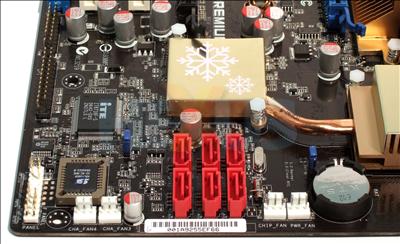Layout and features
Although the board's layout appears fundamentally unchanged from that of the M2N32-SLI Deluxe it never hurts to take a second look and see if ASUS has taken the opportunity to revise any of the issues previously encountered.
At a glance the most obvious change is to the capacitors. Now sporting a funky red-and-silver design as opposed to the black and silver items on the original.
On other boards in the ASUS range this signifies the use of conductive polymer capacitors, which are claimed to offer greater life span and improved thermal characteristics. That's the case here, too.
Beyond this the only other noticeable change is the wireless riser board has gone to make way for the USB flash device.
The positioning of the ATX +12V power connector between this and the PEG slot has, unfortunately, not been changed and makes elegant cabling difficult.
Another small gripe is the proximity of the VRM heatsink to the first PEG slot.
The NVIDIA nForce 590 SLI is not a cool-running chipset and can thus become pretty hot, especially as it is connected directly to the VRMs via the same heatpipe that's designed to keep the two bridges cool. Cards with a two-slot cooler often require you release the retention clip from behind the board, so the position of the upper part of the heatpipe, right by the slot, would not only make this awkward but also could lead to burnt fingers if the system has been in use for a while.
On a more positive note, there are a healthy 6 3-pin fan headers along with a 4-pin PWM header for the CPU fan, and these are nicely grouped around the board.
The 24-pin ATX, IDE and FDD connectors are all ideally placed along the edge of the board, just where you'd want them.
As previously mentioned in the M2N32-SLI Deluxe review, the ATX and IDE connectors both overlap slightly, which can make tidy routing the IDE cable tricky.
Perhaps the biggest disappointment comes from the fact that ASUS hasn't taken the opportunity to relocate the SATA ports. As before, headers 1 and 2 are positioned directly in line with the second PEG slot. This means that if you want to use a pair of GeForce 7900 or 8800-series cards in SLI then you are restricted to the remaining four ports.
A look at the PCIe and PCI slots serves to highlight just how poorly positioned the ATX +12V connector is.
It would also have been nice to see the positions of the x1 and x4 PCIe slots switched, as in a high-end system the x4 slot will almost certainly be rendered unusable by the graphics card's cooler. Not a big issue now due to the limited numbers of x4 cards on the market, but a simple oversight that could limit users long-term.
The positioning of the VRMs and ATX +12V connector also serves to rob the board of its seventh expansion slot, again a minor concern but something that could have been improved upon.
On the far right, above the USB header (in blue), are the header pins for a Trusted Platform Module, a requirement for using BitLocker in Windows Vista Ultimate Edition. This header is silk-screened on the Deluxe version of the board but lacks the pins.
ASUS doesn't include the module itself so if you want to use that feature you'll have to buy this separately.
Around the back and as expected things haven't changed, this time however there are no complaints.
The inclusion of both coaxial and optical outputs along with the standard stereo jack outputs from the ADI 1988B 8-channel High Definition Audio CODEC is good to see, as are the eSATA and FireWire ports.
Summary
While the overall layout of the board is fundamentally sound it's a shame ASUS hasn't taken the opportunity to address any of the niggling issues.
Even more disappointing is the fact that ASUS's own CROSSHAIR board shows that it is clearly more than capable of producing an nForce 590 SLI layout with most these issues resolved while packing in even more in the way of features.














